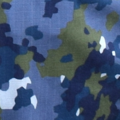Australia
Army
On 19 November 2010, after trials by Australian special operations forces, the Australian Defence Force announced that MultiCam will be standard for all regular Australian Army personnel in Afghanistan. MultiCam, it is said, provided
... troops with greater levels of concealment across the range of terrains in Afghanistan – urban, desert and green.
Previously, depending upon the terrain, Australian troops had to transition between green and desert colored Australian Disruptive Pattern Camouflage Uniforms (DPCU or AUSCAM). [13] [14]
On 30 May 2011 the Defence Material Organisation announced that they had obtained licence to produce MultiCam in Australia for US$4.7 million and Crye would also design a new uniquely Australian pattern for another US$3.1 million. [15]
The Australian Army decided to standardize MultiCam-patterned uniforms starting in October 2014 called the Australian Multicam Camouflage Uniform (AMCU). The Australian derivative retains colour and pattern elements of the previous DPCU pattern.
The AMCU is manufactured domestically by Australian Defence Apparel and Pacific Brands Workwear Group and comes in two variations, field and combat, using a tested Australian Multi-Camouflage Pattern that can operate in bush, desert, and jungle conditions. Previous DPCU Uniforms and Australian MultiCam Pattern Operational Combat Uniforms will be worn until all Army personnel have been issued with the AMCU. [16]
Air Force
In 2014 the Royal Australian Air Force began fielding a new MultiCam-based uniform to replace the DPCU, called the General Purpose Uniform (GPU), using the blue-and-grey colours of the RAAF. [17] The uniform is not intended to be used as camouflage in warlike operations or environments. [18] [19]
In June 2025 it was announced that the RAAF would transition to the Australian Multicam Camouflage Uniform by the end of the year as part of efforts to prepare the force for warfare in Australia's region. The GPU will continue to be authorised for wear on RAAF bases, but not on operations or exercises. [20]
Navy
In 2015, the Royal Australian Navy began their own testing of a new MultiCam uniform with a blue colourway, calling it the Maritime Multicam Pattern Uniform (MMPU) [21]
The new uniform and pattern were intended to replace the Navy's grey-and-green Disruptive Pattern Naval Uniform (DPNU) by 2017. [22]
In 2019, the Navy announced that it was fielding a variant of the new AMCU including the design and cut of the uniform itself, and reverting to the grey-and-green colours of the DPNU. [23]
United Kingdom
The colors of the MultiCam pattern were used in the development of the British armed forces Multi-Terrain Pattern (MTP).
British forces deployed in Afghanistan used MTP uniforms from March 2010 onwards, with these uniforms replacing all Disruptive Pattern Material (DPM) uniforms by 2013.
The colors used in Crye's MultiCam technology were determined to be the best performing, across the widest range of environments (by a significant margin) when compared with the two existing DPM designs in use at the time and was subsequently selected as the basis for the new MTP camouflage, combined with the existing DPM base pattern. [24] [25]
In June 2020, the Royal Marines announced the adoption of a new uniform made by Crye which uses the original MultiCam pattern instead of MTP, though the compatibility of the two designs means that items of load carrying equipment produced in MTP continue to be on issue; [26] [27] prior to this, usage of original MultiCam as an issued uniform (as opposed to items privately purchased by individual personnel) was limited to United Kingdom Special Forces units. [28]
United States
MultiCam is currently in use by the U.S. Special Operations Command, [29] and some private military contractors. [30] Several members of the U.S. Army's Charlie Company, 2nd Battalion, 12th Infantry Regiment were also seen wearing MultiCam when followed by ABC News. [31]
In 2010, U.S. soldiers deployed to Afghanistan were issued MultiCam versions of the Army Combat Uniform, as the existing Universal Camouflage Pattern (UCP) was found to be inadequate for the terrain, under the designation Operation Enduring Freedom Camouflage Pattern (OEF-CP or OCP). [32] [33]
The U.S. Army discontinued the use of UCP in October 2019. [34]
In May 2014, the Army selected a pattern similar to MultiCam called Scorpion W2 to replace UCP, naming it the Operational Camouflage Pattern (OCP). [35] [36] The original Scorpion pattern was jointly developed by Crye Precision and the Army for the Objective Force Warrior program in 2002, and Crye made small adjustments for trademark purposes to create MultiCam. Because Scorpion is similar to MultiCam, the same color Velcro, buttons, and zippers can be reused. OCP resembles MultiCam with muted greens, light beige, and dark brown colors, but uses fewer beige and brown patches and no vertical twig and branch elements. [37]
On 31 July 2014, the Army formally announced that OCP would begin being issued in uniforms in summer 2015. [38] Soldiers were allowed to continue wearing uniforms and field equipment patterned in MultiCam until they could acquire OCP, which was allowed until the MultiCam uniforms' wear-out date on 1 October 2018. [39]
The U.S. Air Force also subsequently adopted OCP uniforms, starting 2018 with full phase-on April 1, 2021, replacing the previous Airman Battle Uniform.
Some local, state and federal law enforcement agencies [40] also make use of the pattern, including the Drug Enforcement Administration's Foreign-deployed Advisory and Support Teams (FAST) teams operating in Afghanistan as well as the U.S. Immigration and Customs Enforcement's Special Reaction Team, the Spokane, Washington Police Department, and the Oregon State Police SWAT team.






















































